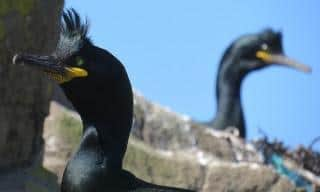Seabirds under the microscope in new study of toxic pollution around Forth
Scientists from the UK Centre for Ecology & Hydrology (UKCEH) and the University of York are to investigate the effects of contaminants on the health, reproduction and survival of seabirds, using European shags as a case study.
Rubbish produced by humans and sent to landfill contains a mixture of substances that can be harmful to organisms and the environment, including unused medicines, pesticides, flame-retardants, metals and plastics.
Advertisement
Hide AdAdvertisement
Hide AdThe deterioration of ageing waste disposal sites coupled with coastal erosion could result in poisonous chemicals leaking into surrounding ground and water.


Such sites may act as a hotspot source, adding to other pollutants entering the environment from mining, coal gasification and fly-ash spoil sites, as well as wastewater.
The Firth of Forth has been chosen as the focus of the study because the area has many major sources of pollutants, including more than 100 operational and disused waste sites as well as significant industrial and domestic wastewater discharges.
The area is also home to important populations of protected seabirds, which are already struggling for survival due to the effects of climate change.
Project leader Dr Francis Daunt, of UKCEH, said: “Populations of many species of UK seabirds such as shags, kittiwakes and guillemots are struggling due to climate change, including reduced prey availability due to warming sea temperatures and fatalities caused by more severe storms.
“ Therefore, it is particularly important to understand the impacts of the additional threat posed by contaminants from waste.
“Persistent toxic chemicals can transfer and accumulate through the aquatic food web, and there is particular concern for the well-being of seabirds as top predators.
“They can also ingest pollutants in water or sediment directly while foraging for prey.”
Advertisement
Hide AdAdvertisement
Hide AdThe researchers will look at the impact on European shags specifically because they feed in coastal areas and eat fish that live at the bottom of the sea, meaning they could have high exposure to pollutants from disused waste sites.
The team will analyse the health and survival rates of shags on both the Isle of May and Inchkeith island to assess whether the birds’ distance from the main sources of pollutants has an effect on contamination levels.
Results between birds that spend the whole year in the Forth with those that migrate to other locations in winter will also be compared.
Professor Alistair Boxall, of the University of York, added: “Wildlife and ecosystems in the Firth of Forth are exposed to a complex mixture of chemicals originating from waste, produced by the large number of people living close to the coast.
“We will develop a risk assessment framework to inform future policies on managing waste in coastal regions.”
The three-year study is funded by the Natural Environment Research Council and will be used to inform waste and chemical management policies in coastal regions across the UK.
A message from the Editor:
Thank you for reading this article. We’re more reliant on your support than ever as the shift in consumer habits brought about by coronavirus impacts our advertisers.
If you haven’t already, please consider supporting our trusted, fact-checked journalism by taking out a digital subscription.
Comments
Want to join the conversation? Please or to comment on this article.
